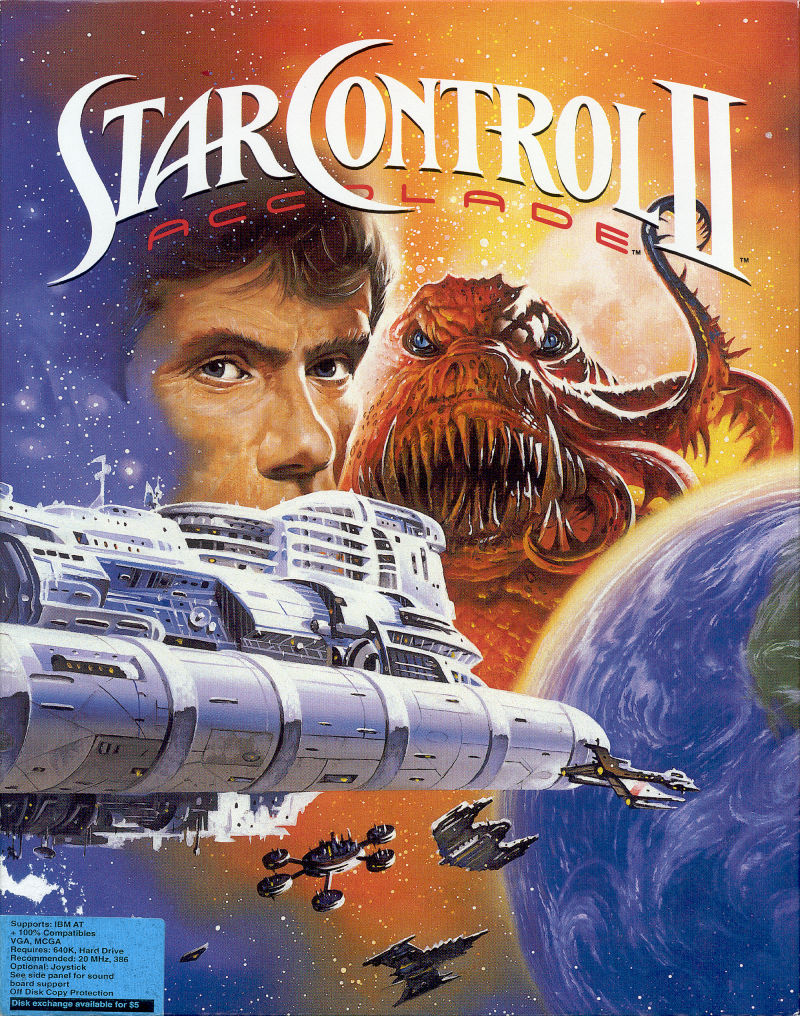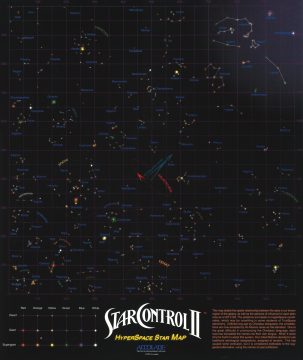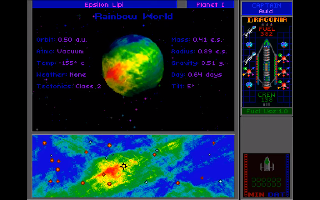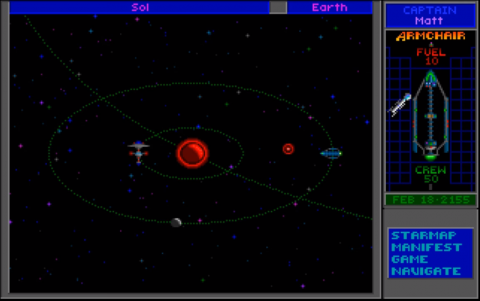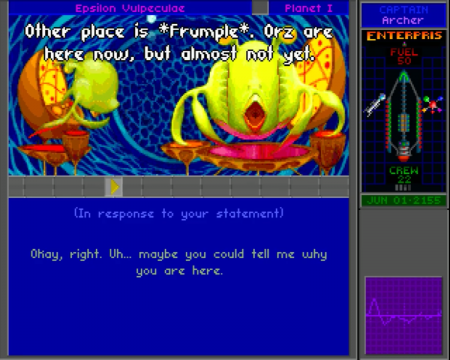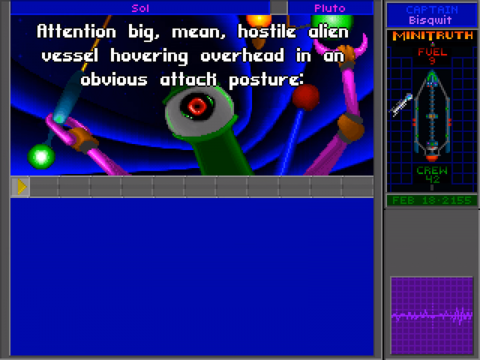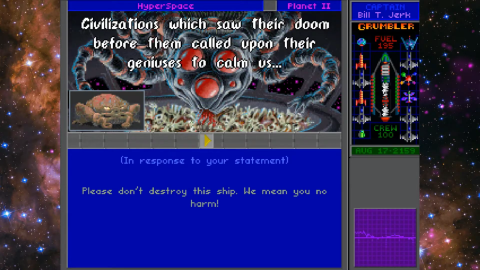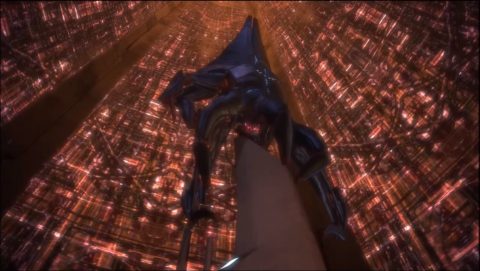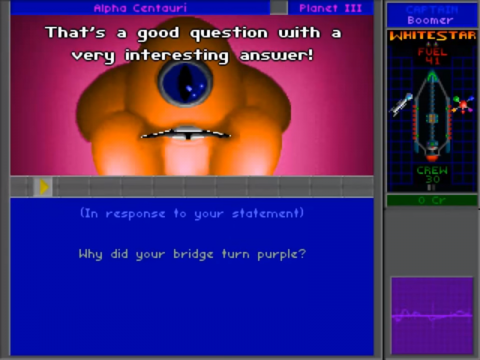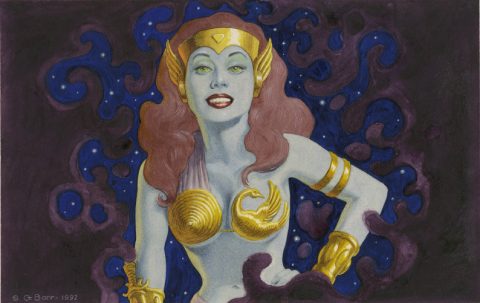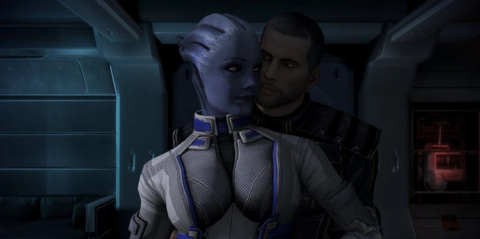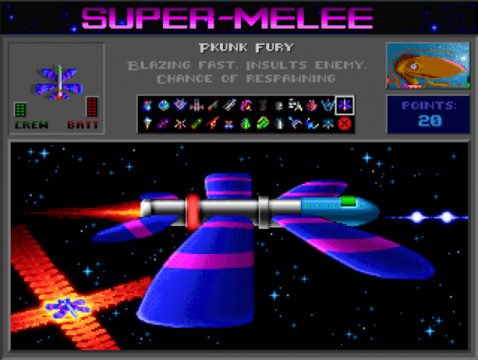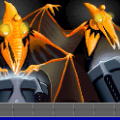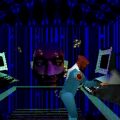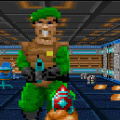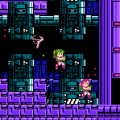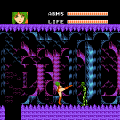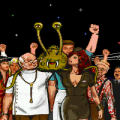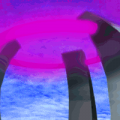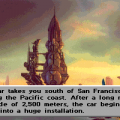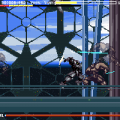- Star Control
- Star Control II
- Star Control 3
- Now and Forever: The Legacy of the Star Control II / Free Stars Universe
Edited by Kurt Kalata
The stars have always sparked our imagination. You see it when fans react to blockbuster space games such as No Man’s Sky, Stellaris, or Mass Effect. But if you talk to an older generation, they may have something to say about a game from 1992 called Star Control II.
Notable fans of Star Control II include Sean Murray of Hello Games, who mentioned the game’s influence on No Man’s Sky for its freedom of exploration. Another admirer is game director Henrik Fåhraeus of Paradox Interactive, who based Stellaris on Star Control II as much as Europa Universalis. And the Star Control II universe is a major influence on countless artists behind the Mass Effect series, as high up as Bioware founder Ray Muzyka.
Star Control II is frequently ranked among the best games of all time. Fans are still quoting the game’s unforgettable dialog, and analyzing its deep mysteries. But there’s still the mystery of why this game has such a cult fanbase, including some highly notable creatives in the industry.
A Vast Galaxy
Star Control II is known for its vast open universe. With nearly 4000 planets, it’s still one of the biggest open worlds in gaming, a feat that has since been topped by No Man’s Sky. And similar to the development of No Man’s Sky, building this huge setting was a major challenge for Star Control II’s creators, Fred Ford and Paul Reiche.
The universe design started with a scientific approach. Keep in mind this was the early 1990s, and no one had officially confirmed any planets outside our solar system. Reiche tried to simulate a galaxy based on astronomical data. But every algorithm kept producing repetitive planets. After some discussion, Reiche and Ford designed more hand-crafted content, creating gem worlds, treasure worlds, and even cracked planets.
Exploring these planets became a central part of Star Control II. The player can land on thousands of worlds, driving a lander vehicle to find resources, lifeforms, and artifacts. These worlds were placed around stars, and those stars were arranged into familiar constellations such as Orion and Centauri. The end result is the game’s famous 2D starmap, included both as a navigation screen and as a full-sized paper poster.
Exploring this galaxy was inspiring. The developers of No Man’s Sky made it their goal to recapture this same feeling. It also inspired the team at Bioware, who designed the Mako from Mass Effect as an homage to the lander in Star Control II. The game even influenced the exploration-driven gameplay of Stellaris. We personally asked game director Henrik Fåhraeus what Stellaris learns from the Star Control II universe.
“There is obviously the general focus on exploration. The galaxy is full of wonders and horrors,” he explains. “Star Control II also has excellent pacing and progression, with your ship upgrades, and the small fleet of other vessels you acquire. However, I do wish it was more procedural, and thus more surprising and replayable,” making it obvious why Stellaris is designed with a more robust galaxy-generation system.
Fåhraeus mentions other similarities. “Aspects I would highlight include the way in which hostile species make threats, the relatively cartoony species graphics and, of course, bird and mushroom aliens.”
Star Control II has inspired many games with its artwork, writing, and huge explorable universe. And if you ever wonder why this sequel gets more attention than the first game, it’s because Star Control II was such a breakthrough in worldbuilding.
Expanding the Universe
The first Star Control is unique, yet simple. As a tactical-action game, players take turns positioning their starships to trigger real-time dogfights. The sci-fi designs were rich with personality, and set the tone for the sequel. To understand the impact of these two games, we spoke to industry veteran Mike Laidlaw, CCO of Yellow Brick Games, and Bioware alumni known for his work on Dragon Age and Mass Effect.
“Star Control II took a relatively bare-bones setting from the original game and fleshed it out,” describes Laidlaw. The original Star Control was mainly an action game about fighting the evil Ur-Quan Hierarchy. “There were some very cool ship designs, and a general sense that there were two alliances at war. That was about all you got for narrative.”
“Flash forward to Star Control II and you suddenly have a rich tapestry of races, a mystery of how the alliance lost and why the Ur-Quan have suddenly disappeared.”
An example of this growth is the way each game treats the Precursors, a lost alien civilization. The first Star Control lets you find Precursor artifacts as simple power-ups. In the sequel, the Precursors are given a deeper mythos and meaning. A core part of Star Control II is learning the Precursors’ ancient history, and uncovering the secrets of their powerful technology.
This means that the Precursors lead you to explore. As you search the galaxy for lost Precursor relics, you also find strange “Rainbow Worlds”. These multi-colored planets are unreal, even by science fiction standards. But the story hints that these odd worlds are caused by some kind of Precursor experiment, justifying Reiche and Ford’s colorful designs as part of the mystery.
Star Control II is celebrated for its masterful writing. The Precursors are one of the game’s most memorable mysteries, with a clear influence on Mass Effect’s Protheans. But the story is also memorable for how it’s told, seeding its many subplots across hundreds of stars. This style of storytelling is unique to games, and only possible in a well-crafted open world.
“Star Control II built an incredible universe and then threw you out into the open to explore and peel back the mysteries on your own,” says Laidlaw. “You had clear leads to follow. But they quickly multiplied, and you found yourself tracking down all these intricate little plots and revelations until you could bring them together into a final, grand solution.”
Evil Worldbuilding
Star Control II throws you into its open universe with unprecedented freedom. You begin as the captain of a rare starship, and the game offers no guidance other than pointing you at Earth. As you fly closer, you see your first glimpse of a “slave shield”, an ominous energy barrier that has imprisoned our planet. It immediately sparks questions about who did this to us, and why.
Since the game is designed around flying starships, it would have been too technically difficult to let the player land on Earth. But the slave shield is much more compelling as an obstacle. When you contact the human starbase, you hear about our fatal last stand against the Ur-Quan. After brutal losses, we surrendered as “Fallow Slaves”, and Earth was encased in a red forcefield. Even as a cluster of pixels, the slave shield is one of the game’s most haunting symbols.
This domination runs deeper as you explore other worlds. Every civilization can recall the tragic day they fell to the Ur-Quan. These overlords gave each defeated race a choice: become Fallow Slaves under a slave shield, or become “Battle Thralls” in the Ur-Quan armada. Of course, these fleets of Battle Thralls will conveniently block you from landing on alien homeworlds, same as the slave shield. But you won’t notice this limitation until you’ve visited a few homeworlds, which is enough time for the aliens to hook you with their story and personality.
This is arguably Star Control II’s hidden strength, that it transforms its technical limits into great storytelling. The writing is a masterclass in justification. Of course, it helps when these justifications lead to some fascinating ideas. You can thank Star Control II for introducing “Battle Thralls” to our popular culture, including a notable cameo in Stellaris as an imperial policy. And Stellaris also emulates the iconic slave shield with its “Global Pacifier” forcefield. Star Control II is jam packed with these unforgettable concepts, which are weaved into its wondrous setting.
“The game has a unique atmosphere, balancing a knife’s edge between pure camp and dark subject matters,” explains Fåhraeus. “I love the narrative tone and atmosphere. It manages to be light-hearted even with its quite horrific backdrop of genocidal aliens sweeping the galaxy.”
The Heart of the Stars
Star Control II is sometimes dark, sometimes strange, and often hilarious. And then there are alien races like the Orz, who showcase the game’s best qualities all at once. These strange entities have their own “untranslatable” language, which has been imitated by other authors for their own inscrutable aliens. Star Control II fans will often find themselves quoting the Orz, which might make them the most popular characters in the game.
Mike Laidlaw praises the Orz as his favorite character design. “Everything about them is so cheery and fun, from their music to their voice acting. And they look so silly. And yet, every single thing they say *drips* with menace and I love them for it. The subtle hints that they’re a hive mind or extensions of some otherworldly horror? … It’s just so perfectly *FRUMPLE*.”
The Orz embody the best parts of this setting — mystery, comedy, and unspeakable horror. The setting is tied to its rich lore, and the game builds its universe with each alien encounter.
The game’s first battle is against the spider-like Ilwrath, acting as Battle Thralls for the Ur-Quan. Their cruelty sets them up as a solid enemy. But the Ilwrath’s zeal for their evil twin gods, Dogar and Kazon, puts them over the top. As an early interaction, they hint at the absurdity to come.
Also guarding the solar system is Captain Fwiffo, a cowardly pilot from the clam-like Spathi. Before you can say a word, Fwiffo surrenders, leaks the location of the Spathi homeworld, and confesses their secret cypher, “Huffi-Muffi-Guffi”. The game jumps into the ridiculous, with Fwiffo sharing his life story as the youngest child in a family of 18,487 molluscs. He doesn’t hesitate to leave the Ur-Quan Hierarchy and join your fleet (assuming you don’t kill him out of disgust — the story will adapt to surprising choices). And if you follow Fwiffo’s directions to the Spathi homeworld, you can befriend the equally ridiculous Spathi High Council.
Star Control II is eager for you to meet its most hilarious characters. In another early encounter, you hear from the Zoq-Fot-Pik, a union of three bantering species. These small plushy aliens are excited to join your alliance. But they are even more excited to tell you about their bizarre culture, including a running gag about a sport called Frungy. These oddball details have made the Zoq-Fot-Pik into an easy fan favorite, almost an unofficial mascot for the game. (When I asked Mike Laidlaw his favorite Star Control II race, he replied, “it’s tempting to just yell ‘FRUNGY!’ and run away screaming, because the Zoq-Fot-Pik rule in every way.”)
After you bond with these characters, the game will hit you where it hurts. If you don’t step up as an ally, the Zoq-Fot-Pik will be the first to be annihilated. And even though you can befriend the nervous Spathi, they will later reverse-engineer Earth’s slave shield, and imprison themselves on their homeworld. The fate of the Spathi is so perfectly consistent with their personality. And these turning points are heightened by the game’s dynamic starmap. It’s surprisingly grim to see your allies wiped from the charts, a tragedy that can only be imagined.
The starmap is also a scene for your triumphs. The Spathi leave you a parting gift, a tool to trick the overzealous Ilwrath. It leads to some comical dialog, and it’s strangely satisfying to see how the Ilwrath respond on the starmap. In fact, the starmap displays how many of your actions affect the galaxy, with allies advancing and enemies falling back. From an era when open world games were still rare, the Star Control II universe feels not just open, but alive.
“You felt like you had a real impact on them over time. Some beats were scripted … but you really felt like you earned [those] moments,” recalls Mike Laidlaw. “Those kinds of moments, where gameplay blended with story, blended with real-time combat and resource management were basically unheard of in 1992, and left a lasting and well-deserved impact on the industry.”
Character References
Star Control II also left a mark with its iconic characters. There are the arachnoid Ilwrath, whose story runs deeper than their fanatical zeal. The Ilwrath reveal that the Ur-Quan improved their technology and weaponized their civilization, a plot twist that anticipates the story behind Mass Effect’s Rachni. There’s also the enduring influence of the Yehat, a militant species of avian dinosaurs who share several qualities with Mass Effect’s Turians. But the biggest lesson from Star Control II is its intentional writing, giving every character a deeper history and motivation.
“The Yehat were deeply ashamed of what they saw as their own betrayal… And they all had a role that enriched the tapestry of the universe,” explains Laidlaw. “It’s a game that informed one of my core design/writing philosophies, which is that if people care about the characters, and the characters care about what’s going on, people will care about what’s going on.”
Star Control II is loaded with engaging characters. The Ur-Quan are a menacing antagonist, in their actions, words, and appearance. And yet, it’s strange that they don’t just crush you. A central part of the game is uncovering the Ur-Quan’s true motives, and learning that their actions have an explanation. Their terrible history evokes a classic “sympathy for the devil”, a dramatic moment that many authors only hope to achieve. The Ur-Quan are rightfully ranked among gaming’s greatest villains, and have left an impact on the industry. Many people have noted that the dark Ur-Quan Kohr-Ah could easily be mistaken for a Reaper from Mass Effect, with their black dangling silhouette and ominous voice dialog. (Still, the Reapers’ goal to harvest sentience probably owes more to Star Control 3 — a less celebrated but still worthy game.)
Another influential race is the Melnorme. These odd-eyed golden nomads are masters of trade, and information is their favorite currency. Round and soft, you might compare them to the Volus of Mass Effect. (Though writer Mike Laidlaw says this wasn’t intentional and more of “a funny if wonderful coincidence”.) The Melnorme are a clearer influence on the Curators from Stellaris, who quote them when you ask about their distinct background art. Both races will tell you “that’s a good question with a very interesting answer,” and ransom their secret for an impossible price.
The Melnorme’s background is yet another lingering mystery from Star Control II, and the direct quote in Stellaris is proof of that longevity. This is just one of many loving tributes: the Dathnak of Stellaris appear to take after Star Control’s Slylandro, as both aliens are sentient races of vapor living in a gas giant, observing history in sweeping cycles of time. And the marauders of Stellaris let out a battlecry that is identical to that of the brave Shofixti. I mentioned these allusions to Henrik Fåhraeus, who noted a few Star Control II fans on his team. “For myself, I only wrote some of the hostile species greetings and threats while consciously thinking of Star Control II, but I’m sure some of the content designers have also been inspired by that game.”
The Effect
For all the creatives inspired by Star Control II, the strongest influence is on Mass Effect. Mike Laidlaw explains, “the inspiration is all over the Mass Effect series. Rich stories, featuring a human who finds themselves thrust into a galactic conflict against dire, overwhelming foes bent on universal extinction is a great common theme. And of course we can’t forget the Mako, which was a direct nod to the lander gameplay of Star Control II.”
You can see this influence in the Syreen. These characters share many similarities with the Asari of Mass Effect, a connection that has been noted by Bioware writer Patrick Weekes. In addition to being feminine blue humanoids, both races have innate psychic abilities. They also share similar cultures, with both civilizations having utopian overtones of cooperation and enlightenment. And of course, both Liara and Talana will offer a romantic moment just before the epic finale, played in each game’s signature style: Mass Effect justifies their interspecies affair with sincere complexity, where Star Control II gets its chance to poke fun at the alien sex trope. (After all, their ship is called the Syreen Penetrator.)
An interesting twist is the destruction of the Syreen homeworld. The Syreen are forced to survive in the cold void of space, similar to the Quarians of Mass Effect. But this resemblance is more likely the shared influence of Battlestar Galactica. It’s telling that the Quarians are devastated by robots of their own creation, much like the plot of the 2004 Battlestar remake. The Syreen are instead attacked by the haywire creation of a lost civilization, similar to the 1978 Battlestar story. It’s the same artistic DNA from two different generations. And they each set up a riveting conflict, whether it’s the Syreen versus the Mycon, or the Quarians versus the Geth.
Mass Effect’s clearest homage to Star Control II is likely the Krogan. Just like the marsupial Shofixti of Star Control, the Krogan earn galactic notice for two advantages: their bravery in battle, and their rapid birth-rate. Both the Shofixti and Krogan are “uplifted” into space by their new allies, who expect their military support. And both species later find themselves on the brink of extinction. It’s a compelling setup for the Shofixti, and Star Control II allows you to champion their recovery, dramatically shifting the central conflict. Their comeback story is so satisfying, it’s easy to see why Mass Effect stretches the Krogan revival across three games.
The Krogan also have traits of the quick-tempered, tough-skinned Thraddash. Both species are so intensely war-like that they have nearly destroyed their own worlds. In fact, the Thraddash have destroyed themselves several times over, to comedic effect. You can ask Thraddash Culture Nineteen to describe their civilization’s many violent and petty wars, giving you some of the funniest dialog in Star Control II. But where the Thraddash are written as a satire of glorified violence, Mass Effect writes the Krogan as tragic allies waiting for redemption.
Both the Krogan and Thraddash have the power to shift the war. But what’s remarkable is how the Krogan are sent to eradicate the Rachni, echoing a moment where the Thraddash are pitted against the spider-like Ilwrath. Events like this feel like a friendly wink to Star Control II, a moment where one generation of artists returns to the older universe that inspired them.
A Toast to the Precursors
Star Control II has left an impression all over the game industry, and not just other space titles. Tim Cain has called Star Control II his favorite computer role-playing game, and it inspired him to create Fallout with the same open-endedness. Star Control II is also a favorite of Greg Kasavin, the Creative Director at Supergiant and writer behind Hades. It’s even a favorite for Todd Howard of Bethesda, and it begs many questions about his team’s next project, Starfield. Bioware veteran Dorian Kiekan recently reported that Bioware once explored making a Star Control II inspired game in the Mass Effect universe. And before you quip that they already made Mass Effect, we can point to the big shoes that Star Control II has left unfilled.
This cult classic is still waiting for a proper continuation. Star Control 3 did continue the events of the sequel, albeit in a new setting created by a different team. Released in 1996, Star Control 3 ultimately marks the last official entry to the series, thanks to a complicated split in the intellectual property. Fred Ford and Paul Reiche have promised to eventually continue their story, as they still own the copyright to Star Control II / The Ur-Quan Masters. There are still many fans who would love more stories about the Alliance of Free Stars, in the classic free stars universe
Everyone who has played Star Control II has a favorite quote, a favorite ship, and a favorite alien. Henrik Fåhraeus mentions the mystical Pkunk as his favorite species, along with his soft spot for bird-like aliens in general. The Pkunk are yet another fantastic character, with their own rich story as the peaceful cousins of the war-like Yehat. Star Control II has too many highlights to mention, which is why fans are still talking about it.
This passionate fandom is perhaps the classic game’s greatest legacy. The Star Control II community has ported the game to modern computers, thanks to the blessing of the game’s creators. This open source remake, The Ur-Quan Masters, has been downloaded two million times, and has itself earned rankings as one of the best free games.
There is also the fandom around Star Control II’s incredible soundtrack. The music was made using the Amiga MOD format, which is part of why it stands out from other games from the early 1990s. This soundtrack has been featured on several “best of” music lists, and is a delicious slice of electronic music from a special era, between the synth-heavy 80s and the rise of techno.
And then there’s the legacy of Fred Ford and Paul Reiche, who went on to create the wildly successful Skylanders series. But fewer people are aware that a young Kyle Balda animated some of Star Control II’s aliens, decades before he became a successful film director with Minions. There is also Iain McQaig, who wrote dialog for aliens such as the VUX. McQaig went on to create concept art for the later Star Wars films, as well as Guardians of the Galaxy. We may never fully understand all the ways that Star Control II has touched our popular culture.
Reiche and Ford have always been surrounded by talent. Several Star Control II aliens were illustrated by legendary fantasy artists, George Barr and Erol Otus. Reiche has been friends with Otus since his childhood, and he later made friends with ToeJam & Earl creator Greg Johnson. Johnson’s 1986 game Starflight inspired Reiche so much that he volunteered to work on it, and Johnson later helped with Star Control II, bringing their collaboration full circle.
Star Control II has an impressive lineage, and its imaginative universe has touched so many people. The game has become a Precursor artifact in itself: a masterwork created by advanced elder beings. Until the day that we see an official follow-up, we hope that the Star Control II stardust finds its way into another generation of incredible fiction.
